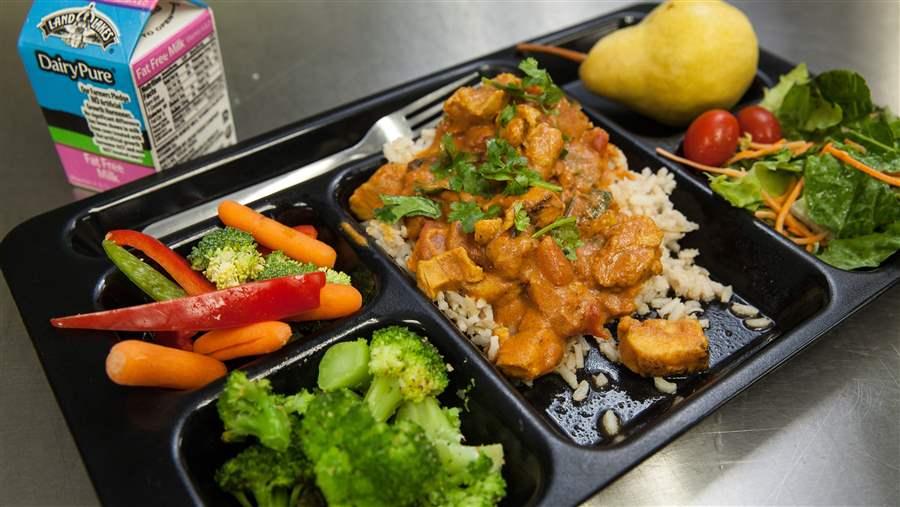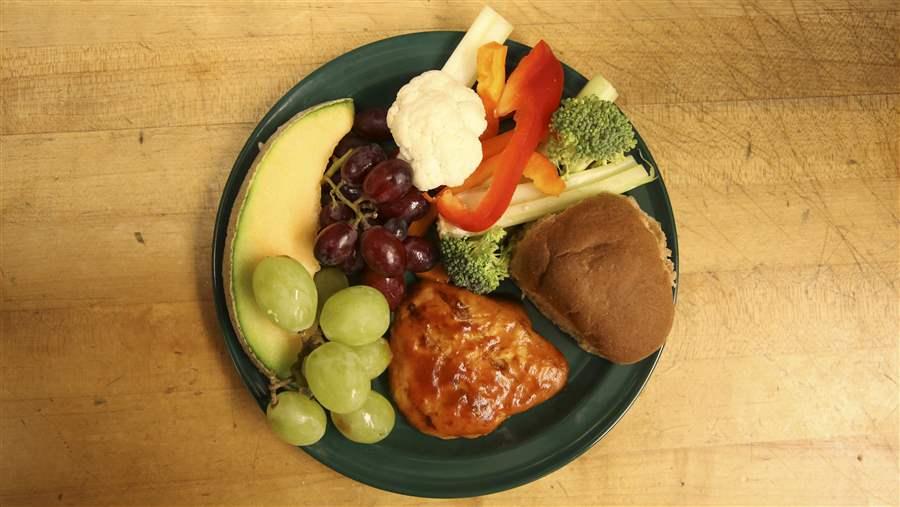5 Ways Healthy School Lunches Meet Goals of National Nutrition Month
 The Pew Charitable Trusts
The Pew Charitable TrustsSchool lunches such as this one from Menomonie, Wisconsin, bring the lessons of National Nutrition Month to life for students across the country.
Every March we celebrate National Nutrition Month, which encourages children and adults alike to eat healthy. In general, that means filling their plates with lean proteins, fruits, vegetables, and whole grains and limiting their intake of salt, sugar, and saturated fat.
As a mother and registered dietitian who counsels other families, I know that establishing habits aligned with this advice is best accomplished early in life and that it’s often easier said than done. The good news is that millions of children get tangible, tasty lessons in eating well when they make their daily trip to the school cafeteria.
Nutrition standards for the national school lunch and breakfast programs were strengthened in 2012 and have helped spur an ever-expanding variety of healthy options for students to choose from. Each lunch that meets these guidelines provides about a third of the daily calories and nutrients a child needs to grow up healthy.
Here are five ways that the dietary recommendations at the heart of National Nutrition Month have been translated to school lunch trays.
- Make half your plate fruits and vegetables. Americans should eat one to two cups of fruits and 1½ to three cups of vegetables daily. The 2012 updates to school meal standards require that each lunch include at least a half cup of fruits or vegetables for elementary students and more for teens—a policy that parents overwhelmingly support. Many schools go even further, offering children unlimited amounts of these healthful foods.
- Vary your vegetables. “Eating the rainbow”—from dark green broccoli and collards to sweet potatoes, tomatoes, and corn—helps Americans get the range of nutrients important to their health. Under current meal guidelines, schools must offer vegetables from several categories over the course of a week.
- Make half your grains whole grains. Science-based dietary guidelines recommend that Americans consume more whole grains than most currently do to make sure that they’re getting healthy amounts of fiber and important minerals. School meal standards require that all grain items served be made from at least 50 percent whole grains.
- Avoid excess sodium. Most Americans, including 9 in 10 school-age children, eat too much salt, which can increase their risk of heart disease and other health problems. Current school nutrition standards include a gradual decrease in the salt in meals so that by 2022, students will get no more than a third of their recommended daily maximum amount of sodium from school lunches.
- Balance calories with energy needs. Individuals’ caloric needs vary to a degree, but a basic principle for maintaining a healthy weight is taking in energy equal to the amount used in daily activities. National school meal calorie ranges rise with the age of the students being served and are calculated on a weekly, rather than a daily, basis. This allows for more variety in menus from day to day, ensures that all lunch options provide enough energy for growing kids, and lets each child choose a meal with the right amount of calories, based on his or her needs.
Guided by these nutrition fundamentals, school cafeterias across America are serving appetizing meals that help kids experience and understand healthy eating. During National Nutrition Month, I encourage parents and other family members to make a school lunch date and enjoy these lessons with their child.
 The Pew Charitable Trusts
The Pew Charitable TrustsStudents in Unity, Maine, are treated to flavorful and nutritious meals such as this one, composed of grilled chicken with a low-fat glaze, fresh vegetables, grapes, a melon slice, and a whole-grain roll.


How to Support Healthier School Food for Your Kids
Make a School Lunch Date With Your KidThis video is hosted by YouTube. In order to view it, you must consent to the use of “Marketing Cookies” by updating your preferences in the Cookie Settings link below. View on YouTube
This video is hosted by YouTube. In order to view it, you must consent to the use of “Marketing Cookies” by updating your preferences in the Cookie Settings link below. View on YouTube






